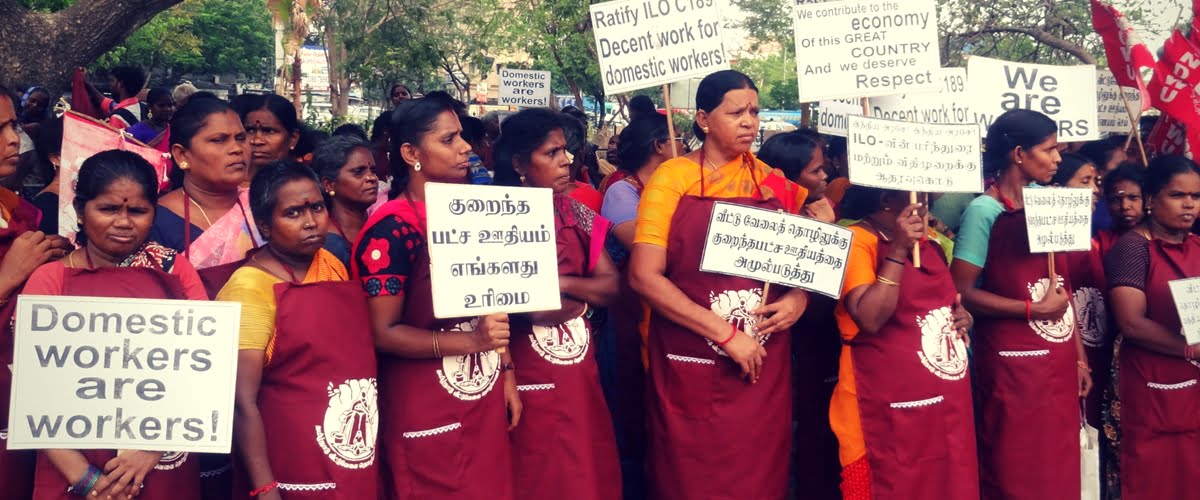Domestic workers are individuals engaging in the unorganised sector whose work generally includes cooking, cleaning the entire house, washing utensils and other household chores. This section of domestic workers comprise of 67 million population worldwide. According to Census 1991 report, 270,835 men and 460,279 women have been identified as domestic workers, majority of whom are women. The devaluation and invisibilisation of the domestic labor traces back to the non recognition of ‘home’ as a workplace. Also, in the context of India, employing a domestic worker is not always a compulsion, but a choice as it is an important status symbol for the middle class population.
The domestic workers are considered to be one of the most vulnerable communities due to lack of social security and the poor pay structure of the same. The Domestic Workers Convention of the International Labour Organisation (ILO Convention No. 189) stated that all domestic workers should enjoy protection against any form of abuse. But, India did not ratify this convention as the national laws present do not fully conform to the provisions mentioned in the Convention. On one hand, in India the domestic workers are not being given enough protection and on the other hand, in this age of digital media, the domestic workers are being ripped off their humanity and are being ‘advertised’ as commodities in several sites.
On one hand, in India the domestic workers are not being given enough protection and on the other hand in this age of digital media, the domestic workers are being ripped off their humanity and are being ‘advertised’ as commodities in several sites.
Also read: Room To Bleed: Do Domestic Workers Have ‘Period Leaves’ Too?
Previously, people used to contact nurse centers when they needed domestic workers who specialised in treating sick individuals or help with taking care of children. Most centers do not have a list of well defined and strict duties which the domestic workers are bound to perform, which often leads to the exploitation of them by the house owners. This tendency of making the ‘maid servants’ overwork due to lack of formal rules and regulations have led to the corporatisation and commodification of this sector. Here the agencies, through websites, advertise the potential ‘candidates’ who can be hired as domestic workers. Their information details regarding Name, Sex, Age, Education and Experience are mentioned so that the ‘buyers’ can make a reasonable choice after going through the same. But are these agencies really helpful for the domestic workers and doing due diligence to ensure safe workplaces for these workers or are they turning human beings into mere commodities?
In most cases, regarding domestic workers, the entire exchange of money occurs solely between the recruiter and the individual who is offering their service. But whenever an agency comes in between, acting as a middle-man, the individual workers’ scope for negotiation for better and humane remuneration that suits their needs gets affected. Not only that, the very humane nature of these individuals are being neglected and denied by the process of objectification. Whenever you are portraying an individual as an ‘object’ in the market, you are not only commoditising the work but the worker also. You are assuming those people ‘available’ for potential recruiters to look at and judge and creating an unnecessarily competitive market around the same. As the display of candidates shows pictures of the same, this can even lead to a biased process of hiring, where individuals might prefer to ‘hire’ or ‘buy’ someone’s service based on the look of the person which may lead to instances of violence in the future. So, is this process actually making their experiences safer or are putting them at more risk?
Whenever you are portraying an individual as an ‘object’ in the market, you are not only commoditising the work but the worker also. You are assuming those people ‘available’ for potential recruiters to look at and judge and creating an unnecessarily competitive market around the same.
Also read: Domestic Workers In India Have No Laws Protecting Their Rights
By advertising the workers through websites, the agencies are portraying them and reducing them to mere products and ‘machines’, which may give rise to unreasonable expectations at the end of the recruiters. They may be asked to deliver their work, under any circumstances, based on the ‘assurance’ given by the agency regarding the same. Hence, the rate of surveillance would increase due to this practice which can make the life of domestic workers miserable. The digital technology have found new ways of commercialising labor and even the labourers through the initiation of such industries, and have been successfully able to eliminate the feeling of compassion by only focusing on marketing and profit making respectively. Hence, are we really helping the labourers by incorporating this digital outlook or should we work towards attaining their basic rights and create a uniform pay structure along with protectionary rules and regulations for them? Are we really thinking about them or benefitting ourselves by making the process of hiring servants more fast and easy?
Featured image source: Economic and Political Weekly
About the author(s)
Brishti Sen Banerjee is a PhD Research Scholar in Indian Institute of Technology, Kanpur. She has experience in formulating research tools, conducting on ground research work and in advocacy. She is a passionate lover of junk food and loves the mountains.




